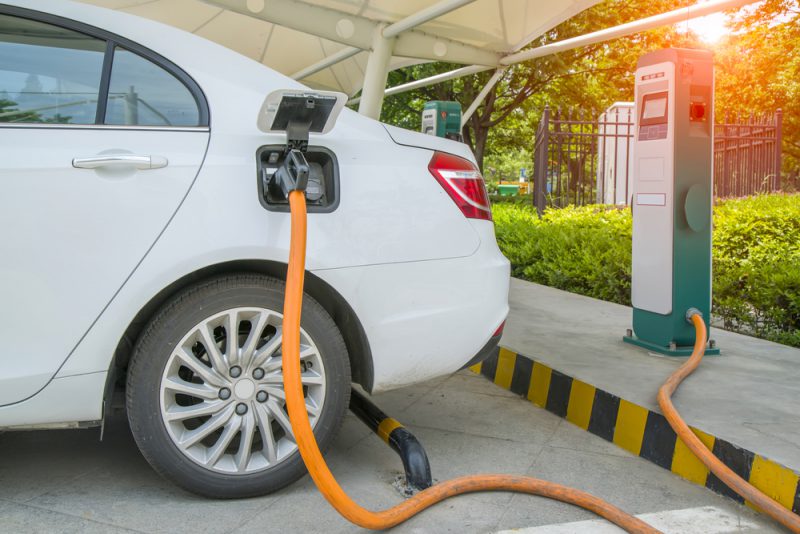Utilities, states work together to expand EV charging infrastructure

Electric vehicle (EV) infrastructure has a long way to go in the United States, but creating a solid plan will help consumers and utilities reach their goals.
The commitment by the United States to the Paris Agreement was to reduce greenhouse gas (GHG) emissions by 26 to 28 percent by 2025, when compared with 2005 levels. Adding electric vehicles to the electric infrastructure could help move the country toward that goal. According to a new report by the Center for American Progress (CAP), there were 113 million fossil fuel-powered vehicles in the United States in 2015. There are currently 800,000 personal EVs (PEV) on the road, with around 18,000 charging stations.
The CAP report said tipping the balance toward widespread adoption of EVs and charging infrastructure would come down to money, and “state and federal policymakers need to find new and creative ways to put more PEVs on the road.”
CAP found that, in order to meet the goals of the Paris Agreement, 14 million new PEVs will need to be added to the road by 2025, along with more than 330,000 public charging outlets (Level 2 or fast-charging DC). Despite current investments, there is still a gap of $2.3 billion (of the $4.7 billion) that will need to be contributed to meet the goals.
Many states are making progress toward their 2025 goals, and nine states currently make up more than 15 percent of Level 2 and DC fast chargers: California, Colorado, Connecticut, Hawaii, Maryland, Nevada, Oregon, Vermont, and Washington. Washington, D.C. has nearly 100 percent of its goal, but no other state is more than 50 percent toward its goal.
However, CAP feels confident reducing emissions is an attainable goal, but only with “a multibillion-dollar investment in a new, electrified system.”
The Volkswagen Clean Air Act Civil Settlement will help fund the progress, in part. The settlement came from allegations from the government that Volkswagen cheated emissions standards.
States are finding different ways to invest in their EV infrastructure, and working with utilities is a useful way to do this. State investment in EV infrastructure, as well as removing any regulatory hurdles, could be the most impactful solution for states.
“Chargers can provide revenue for the utility and at the same time allow for the much-needed deployment of clean transportation solutions,” CAP said. “The role of the utility in financing and operating charging infrastructure is being actively debated in states across the country and many public utility commissions are starting to permit the rate-financing of charging infrastructure.”
Many states are taking the lead in an attempt to increase EV usage and ownership in their own region. Ohio regulators approved a plan earlier in 2018 for American Electric Power Company (AEP) to provide rebates to deploy 300 public Level 2 charging stations and 75 C fast-charging stations.
Ryan Houk, distribution project manager at AEP’s Smart City department, said 150 of the Level 2 Chargers will be used for workplaces and 90 will be dedicated toward publicly-accessible locations, “either through a local government or an entity that wants to make them accessible.” An additional 50 will be used for multi-family, multi-unit complexes, and 100 percent of the fast chargers will be located in public areas.
“Part of our commitment is to place 10 percent of all the stations in areas of low-income so that we ensure everyone has the opportunity to benefit from this program,” he explained.
Houk said he believes there are currently between 9,000 and 10,000 EVs in the state of Ohio. The program was an order from the Public Utilities Commission (PUC) of Ohio in April of 2018, and AEP expects it to be implemented over four years.
“I do believe [this program] will definitely impact and accelerate the adoption,” he said. “As to how fast, that’s anyone’s guess. One of the other aspects that we have going for us is the Smart City and Smart Columbus initiative that is aligned with this effort. That is helping promote electrification as well. I think that these programs combined will have a definite impact on the adoption of EVs in the state of Ohio.”
To meet the Paris Agreement goals of 26 to 28 percent, the United States still needs to reduce light-duty vehicles (LDV) emissions by 16 percent below 2005 levels — because emissions have already been reduced 10 percent.
It will likely come down to individual state and utility projects to create the best potential for reaching the 2025 goals. But creating a strong infrastructure will be an important part to spurring widespread adoption by customers.
“In terms of what it means for the state, it’s really showing how we’re investing in technologies that our customers want,” Houk said. “That’s really what we’re all about: how do we deliver a reliable service that our customers demand and offer the products and services that they want?”
